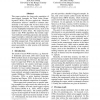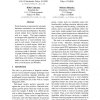180 search results - page 5 / 36 » Unsupervised Relation Disambiguation Using Spectral Clusteri... |
EMNLP
2004
13 years 9 months ago
2004
This paper explores the large-scale acquisition of sense-tagged examples for Word Sense Disambiguation (WSD). We have applied the "WordNet monosemous relatives" method t...
EMNLP
2006
13 years 9 months ago
2006
Word clustering is important for automatic thesaurus construction, text classification, and word sense disambiguation. Recently, several studies have reported using the web as a c...
ICIP
2007
IEEE
14 years 9 months ago
2007
IEEE
A key goal of far-field activity analysis is to learn the usual pattern of activity in a scene and to detect statistically anomalous behavior. We propose a method for unsupervised...
SAC
2005
ACM
14 years 1 months ago
2005
ACM
Because of name variations, an author may have multiple names and multiple authors may share the same name. Such name ambiguity affects the performance of document retrieval, web ...
BMVC
2002
13 years 10 months ago
2002
This paper describes a hierarchical spectral method for the correspondence matching of point-sets. Conventional spectral methods for correspondence matching are notoriously suscep...


